Exam Details
Exam Code
:HPE2-Z39Exam Name
:Fast Track - Applying Aruba Switching Fundamentals for MobilityCertification
:HP CertificationsVendor
:HPTotal Questions
:62 Q&AsLast Updated
:Mar 28, 2025
HP HP Certifications HPE2-Z39 Questions & Answers
-
Question 1:
A network administrator enters this command on an ArubaOS switch:
Switch(config) # trunk 1,2 trk1
What is required for the switch to combine both interfaces in a link aggregation?
A. that the interfaces are up
B. that the interfaces are aggregated while in a shutdown state
C. that the interfaces are up and connect to interfaces that support active mode LACP
D. that the interfaces are up and have LACP enabled on them
-
Question 2:
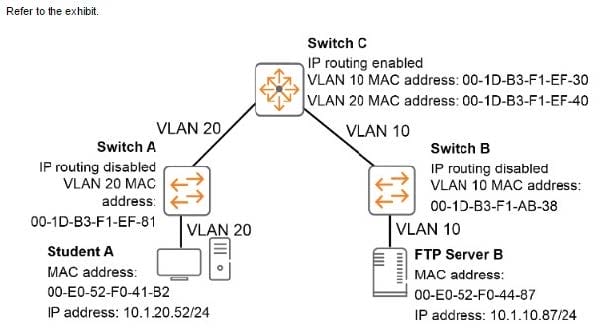
The Student A client needs to connect to FTP Server B. Student A sends the necessary ARP request and receives a reply. Which destination MAC address does the Student A client use in the FTP packet to FTP Server B?
A. 00-E0-52-F0-41-B2
B. 00-E0-52-F0-44-87
C. 00-1D-B3-F1-EF-81
D. 00-1D-B3-F1-EF-40
-
Question 3:
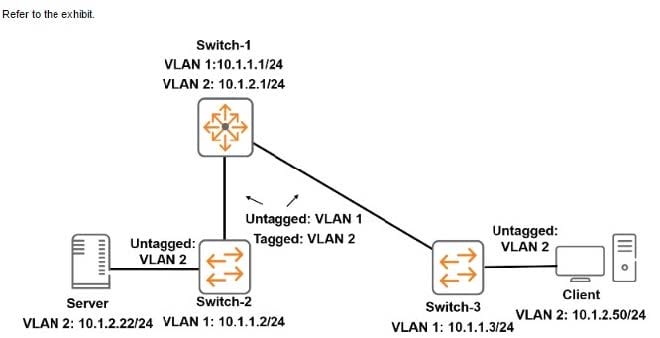
How can the network administrator find the interface that Switch-3 uses to forward traffic from the Client to the Server?
A. View the MAC forwarding table.
B. View the LLDP remote devices list.
C. View the IP routing table.
D. View the ARP table.
-
Question 4:

After the administrator enters this command, packets arrive that are destined for 10.1.8.8 and 10.1.8 13 What does the switch do with this traffic?
A. It forwards all of the traffic to 10.1.101.1.
B. It load balances some of the traffic 10.1.101.1 and some to 10.1.104.2.
C. It forwards all of the traffic to 10.1.104.2.
D. It drops the traffic.
-
Question 5:
A port on an ArubaOS switch has its default spanning tree settings. When is the port defined as a spanning tree edge port?
A. when the switch and the connected switch run MSTP but have different region settings
B. when the switch runs MSTP but the connected switch runs RSTP
C. when the port fails to receive BPDUs on the port within a set period of time
D. when the port is part of a VLAN that is dedicated to that port alone
-
Question 6:
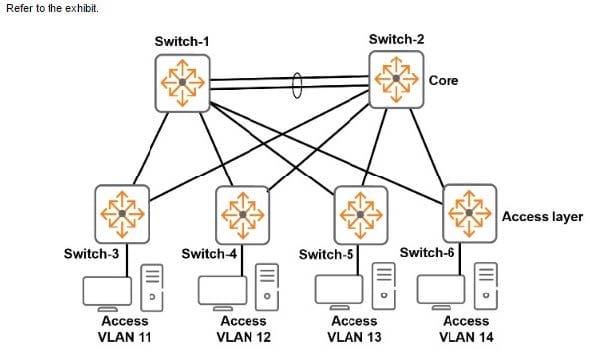
This exhibit shows the topology for a company campus LAN. Each access layer switch will be the default router for the devices connected to it. The company needs to permit the following:
1.
Communications between devices in an subnets
2.
Support for efficient traffic paths during normal operation and in situations in which a link fails
3.
Fast failover if a link fails
Which feature should the network administrator configure on the ArubaOS switches to support these requirements?
A. MSTP
B. RIP
C. Static Routes
D. OSPF
-
Question 7:
A network administrator needs to see the options for the vlan command on an ArubaOS switch. The administrator enters:
Aruba (config)# vlan?
No new output displays.
What should the administrator change to see the vlan command options?
A. Move to the vlan configuration mode before entering vlan? again.
B. Use the Tab key instead of ?.
C. Insert a space in between vlan and ?.
D. Activate help commands globally before entering vlan? again.
-
Question 8:
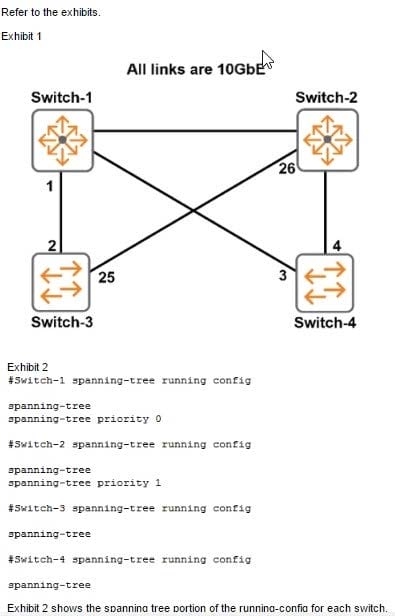
What are two ports with the alternate role?
A. 1 and 2
B. 2 and 4
C. 4 and 25
D. 25 and 26
-
Question 9:
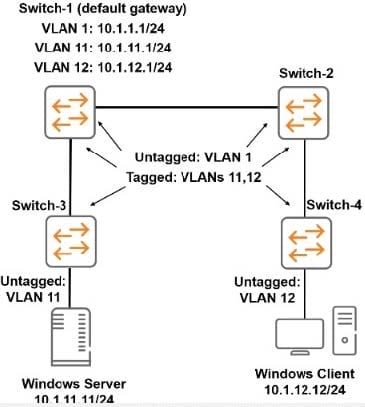
The ArubaOS switches were at default settings. The network administrator configures the VLANs and IP addresses as shown in the exhibit. All inter switch links are untagged for VLAN 1 and tagged for VLANs 11 and 12. There is no additional configuration performed on the switches. The Windows Server and Windows Client are configured to use Switch-1 as their default gateway.
How does this configuration affect the network topology?
A. The Windows Server and Windows Client cannot ping each other; IP routing must be enabled on all switches in the topology.
B. The Windows Server and Windows Client cannot ping each other; the VLANs are tagged incorrectly on one or more ports.
C. The Windows Server and Windows Client can successfully ping each other.
D. The Windows Server and Windows Client cannot ping each other; IP routing must be enabled on Switch-1.
-
Question 10:

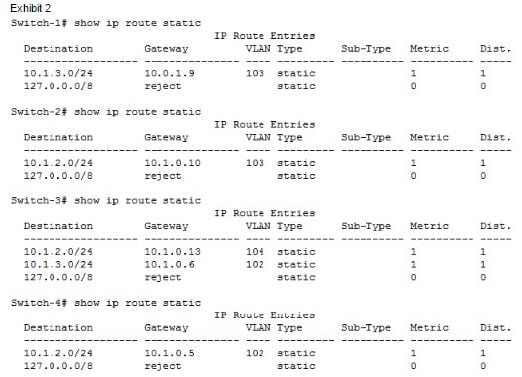
Exhibit 2 shows the IP routine tables for all the switches after the link between Switch-4 and Switch-2 failed '//'hen This link fails traffic between 10 1 3 0/24 and 10.1.2.0724 is disrupted What should the network administrator do to ensure that this traffic continues to flow if this link fails in the future? (Assume that routes on Switch-1 and Switch-3 are correct.)
A. Add a route to 10.1.3.0/24 through 10.1.3 1 on Switch-4.
B. Add a route to 10.1.2.0/24 through 10.1.0.14 on Switch-2.
C. Add a route to 10.1.3.0/24 through 10.1.0.14 on Switch-2
D. Add a route to 10.1.2 0/24 through 10.1.2.1 on Switch-4.
Related Exams:
HP0-D15
Administering HP CloudSystem Matrix SolutionsHP0-D20
Architecting the HP Matrix Operating EnvironmentHP2-E56
Selling HP SMB SolutionsHP2-H88
Selling HP Business Personal Systems Hardware 2019HP2-I14
Selling HP Supplies 2020HP2-I15
Selling HP Business Personal Systems Hardware 2020HP2-I17
Selling HP Printing Hardware 2020HP2-I44
Selling HP Workstations 2022HP2-I73
Selling HP Retail and Hospitality Solutions 2024HP2-N51
HP Application Lifecycle Management 12.x Software
Tips on How to Prepare for the Exams
Nowadays, the certification exams become more and more important and required by more and more enterprises when applying for a job. But how to prepare for the exam effectively? How to prepare for the exam in a short time with less efforts? How to get a ideal result and how to find the most reliable resources? Here on Vcedump.com, you will find all the answers. Vcedump.com provide not only HP exam questions, answers and explanations but also complete assistance on your exam preparation and certification application. If you are confused on your HPE2-Z39 exam preparations and HP certification application, do not hesitate to visit our Vcedump.com to find your solutions here.